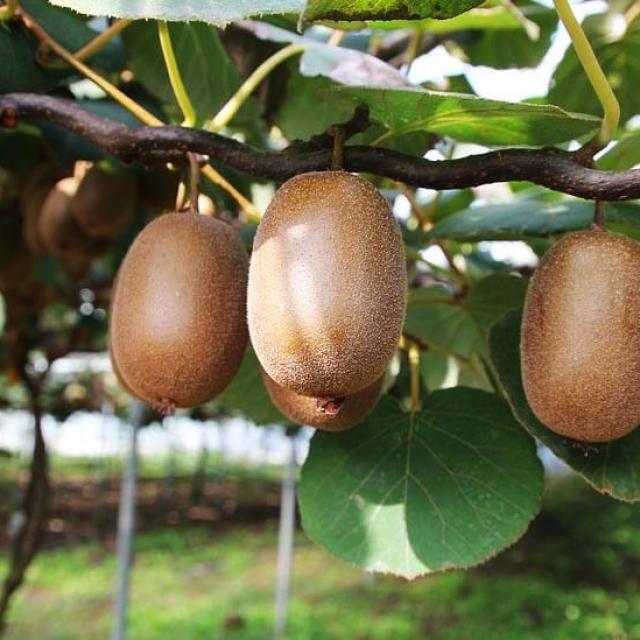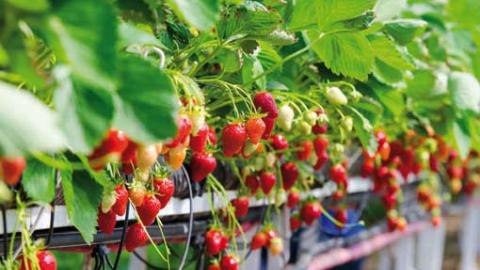The Kiwifruit (Actinidia chinensis) is a climbing plant that resembles the grapevine. It is a native of China, where it has been enjoyed as an edible fruit for more than 2,000 years. Around 1750, the Jesuit Father, Pierre Le Chéron d'Incarville, was the first European to describe this plant. It grew on the edge of forests situated on either side of the Yangtze River. After having evangelised the Chinese, the missionaries would bring the Actinidia to Florida, New Zealand and Europe as a decorative plant. At that time, the fruit was called « Chinese Gooseberry » on account of its colour and the fact that it had a similar taste to the gooseberry

The first plants appeared in France in 1904, at Selva Brancolar near Nice, and at the Botanic Gardens of Paris in 1920. The only female plant studied at the Paris Natural History Museum bore fruit for the first time in 1937, and yielded 85 kg in October 1940. It produced fruit every year from then on!
However, it was not until the 1960s that the kiwifruits were developed on a wider scale. Nowadays, it is grown in France, United States, Japan, Italy, Chile, Greece, etc. 1.45 million tonnes of kiwifruits are produced worldwide every year, with approximately half this amount grown in the Mediterranean region. Italy, with 32% of global production, is the market leader. Then we have two other leading producers, New Zealand (28%) and Chile (16 %). Greece is next with 6.1% followed by France with 5.5 % of the market
Italy, the world’s leading producer, has carried out research into the development of new cultivars, at the University of Udine, for example. France (No. 5 in the world and the third largest European producer) produced a little less than 63,000 tonnes in 2018, including 55% in Aquitaine, 22% in Midi Pyrénées and 2% in Rhône-Alpes.
AGRONOMIC CONSTRAINTS AND TECHNIQUES
Type of soil. Kiwi fruit thrive in soils that are of a medium texture, well-structured, permeable, welldrained and rich in organic matter; and soils of a coherent structure, with a clay content of greater than 25% and rich in silt and fragmented, with large-sized soil particles to ensure that the soil is well drained. Furthermore, the soil should preferably have a low limestone content, with a pH of 6-7.
Kiwi fruits do not grow well in heavy soils as they do not maintain a suitable moisture level. When the soil holds too much water, there is a risk of asphyxiation.
Climate and topography. The Kiwi fruit is suitable for Mediterranean climates. It can withstand temperatures of -15° C. The ideal temperature is 25-30° with a relative humidity of 60% (semi-shaded). Strong winds are very harmful to the Kiwi fruit (risk of uprooting).
Planting the crop. Planting the Kiwi fruit does not present any particular problem apart from requiring tillage to a depth of 80 to 90 cm. The application of organic amendments has to be considered. It is
preferable to use 2-year old plants with a robust rooting system. The plants can be grafted or otherwise, but grafting should take place after planting.
The planting density is around 2,000 plants per hectare. The plants are placed in holes that are 30 to 40 cm deep, and the same diameter, on top of a layer of manure. The planting season can range from the end of the year to March-April, according to the plant material used. Irrigation is then applied daily to the young plants.
• Pruned annually in the same way as the grape vine,
• Irrigation is necessary.
• Grafting/transplanting is possible.
• Support equipment is costly and complex (grown against a wall or fence)
• Tying and thinning is essential for quality yields (2.5 ha of young plants require around 200 hours of tying).
• The pollination must be monitored closely (check insect activity, even install bee hives).
• Challenging harvest (not to damage the fruit) over a short period.
IRRIGATION MANAGEMENT
The Kiwi plant was originally from regions that were subject to monsoons during the period of strong vegetative growth. The plant has not, therefore, developed a mechanism for resisting drought.
Furthermore, transpiration is not restricted during the night, so there is significant moisture loss during the day and during the night. The water requirements are thus quite significant, being somewhere around 2000 m3/ha with peak requirements from mid-May to October reaching 1000 mm/month.
We got in touch with Mr. Fabrice Casterra, director of SCAAP Kiwi France and a farmer himself. SCAAP kiwi France is a farmers’ cooperative created by pioneer Kiwifruit producers in the south-west of France. Today, it has 400 member producers providing an annual production of 15 000 tonnes.
The member producers are located mainly in the South of France: in the Adour Lot and Garonne Basin, in the Drôme region and in Corsica. This cooperative is the leading producer of Kiwi fruit in France. On his 120 hectares in the southern Landes region, in the Adour basin, Mr. Casterra grows mainly maize (corn) together with 12 hectares of Kiwi fruit. The Kiwi fruit of the Adour is rather special because it is boosted by two accreditations: protected geographical indication (IGP) and the Red Label. This label is an indication of its region or country of origin (Gaves, Adour and Pays d’Orthe regions) and the particular specifications or requirements with regard to the sugar content and the harvest to which it relates.
“The soil of the Gaves region is rich in alluvium, a filtering soil favourable for growing Kiwi fruit” explained Mr. Casterra. “There is a stony layer and I am able to draw from the groundwater”. It is a relatively humid climate with frequent frosts. Therefore, Mr. Casterra has two irrigation systems: one with microsprays below for normal irrigation and an overhead system with sprinklers for frost protection.
He irrigates in June, July, August and September, applying 5 mm per day with subsurface micro-sprinklers. Sentek capacitance sensors have been placed in the ground.
“We are trying to improve, little by little”, explained Mr. Casterra. “Some soils are more difficult than others.” Some varieties of Kiwifruit are more sensitive to plant water stress, such as the yellow flesh Kiwifruit or Baby Kiwifruit of the snacking type. The yellow fleshed Kiwifruits prevail over the green ones. There is an advert about this product which comes from New Zealand and it is becoming more and more popular, with a higher sugar content.
The overhead sprinkler system was installed for frost protection. When spring begins, observing when the bud burst occurs (the time of year when the buds of the tree develop) gives a first indication of the quality of the harvest
to be expected later in the year. “This is a difficult period because there is a risk of frost destroying the buds and compromising the harvest” adds Mr. Casterra. If the temperature drops too low, Mr. Casterra will start irrigating:
water is deposited on the buds and turns into ice releasing calories in the process. The temperature inside the cocoon of ice is above freezing and the bud is protected.
Furthermore, Mr. Casterra has used protection netting on the new varieties. Recovering from a disastrous year as far as the climate is concerned, which led to a 42% fall in the volumes sold, many producers have decided to become equipped with these devices. These nets protect the crops from the weather (rain, hail, winds or heat). Furthermore, the netting protects the crops from a disease that develops because of the high sugar content of the new varieties and the humidity: the brown marmorated stink bug. According to Mr. Casterra: “If we compare the current situation with the previous one, we can see that there is a significant difference in the quality as a result of using these protection nets”. The investment is €17,000 per hectare.

